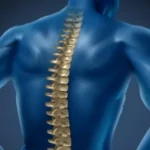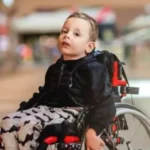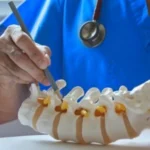What is Bone Tuberculosis?
Bone TB is a form of tuberculosis where the bacteria spread from the lungs to bones and joints, most often affecting the spine.

The condition is characterized by the slow destruction of bone tissue as the bacteria multiply and trigger an inflammatory response. This gradual process often leads to delayed diagnosis, as symptoms may develop slowly over months or even years.
Skeletal tuberculosis can affect various parts of the body, including:
- Spine (also called Pott’s disease or tuberculous spondylitis)
- Hip and knee joints
- Wrist and ankle joints
- Shoulder joints
- Long bones of the limbs
When searching for treatment, finding a specialized bone TB hospital in Delhi is crucial for proper management of this condition.
Causes and Risk Factors of Bone Tuberculosis
Bone TB occurs when TB bacteria spread from the lungs to bones via the bloodstream. Risk factors include weak immunity, chronic illness, and untreated primary TB:
Primary Causes
Bone TB is caused by Mycobacterium tuberculosis, which usually starts in the lungs and spreads to bones via the bloodstream or lymphatic system.
Risk Factors
Some groups are more likely to develop bone TB due to weakened immunity or underlying conditions:
- Compromised Immune System: People with HIV, diabetes, or on immunosuppressive therapy are at higher risk.
- Age: While bone TB can affect people of all ages, it’s more common in children and young adults in developing countries.
- Malnutrition: Poor nutritional status weakens the immune system, making it easier for TB bacteria to establish infection.
- Previous TB Infection: Those with a history of pulmonary TB have a higher risk of developing extrapulmonary tuberculosis, including bone TB.
- Living Conditions: Overcrowded living environments with poor ventilation increase the risk of TB transmission.
- Geographic Location: Bone TB is more prevalent in regions with high TB burden, including parts of India, Africa, and Southeast Asia.
In densely populated areas like Delhi NCR, knowing these risk factors helps detect and treat bone TB early.
Bone Tuberculosis Symptoms
Recognizing bone tuberculosis symptoms early is crucial for timely intervention. The manifestations of bone TB can vary depending on the affected site, but some common symptoms include:
General Symptoms
- Persistent low-grade fever
- Night sweats
- Unexplained weight loss
- Fatigue and general weakness
- Loss of appetite
Localized Symptoms
- Ongoing bone or joint pain that increases with movement.
- Swelling and tenderness around the affected area
- Limited mobility and stiffness
- Visible deformity in advanced cases
- Muscle wasting around the affected area
Spine-Specific Symptoms
When TB affects the spine (Pott’s disease), patients may experience:
- Chronic back pain that worsens with physical activity
- Stiffness and reduced flexibility of the spine
- Hunchback deformity (kyphosis) in advanced cases
- Neurological complications such as weakness, numbness, or tingling in the limbs
- Difficulty walking or maintaining balance
- In severe cases, paralysis due to spinal cord compression
Recognizing early warnings for spine TB is particularly important as it can prevent serious complications like permanent neurological damage.
Early Warnings for Spine TB
Early detection of spine TB improves outcomes. Watch for these signs:
- Persistent Back Pain: Unlike mechanical back pain, TB-related pain doesn’t improve with rest and may worsen at night.
- Localized Tenderness: Specific points along the spine may be tender to touch.
- Mild Fever and Night Sweats: These symptoms may be subtle but persistent.
- Unexplained Weight Loss: Gradual weight loss without dietary changes.
- Stiffness in the Back: Reduced flexibility and mobility of the spine.
- Referred Pain: Pain that radiates to the chest, abdomen, or limbs depending on the affected vertebrae.
- Mild Neurological Symptoms: Early signs of nerve involvement like tingling or mild weakness.
If you experience these symptoms, especially in combination, consulting a bone tb specialist doctor in Delhi is advisable for proper evaluation.
Bone Tuberculosis Diagnosis
Accurate diagnosis of bone TB involves clinical evaluation, imaging, and lab tests:
Clinical Evaluation
Diagnosis begins with a history and physical exam to check symptoms, risks, and visible signs.
Imaging Studies
Various imaging techniques help visualize bone abnormalities:
- X-rays: Often the initial imaging test, showing bone destruction, joint space narrowing, or spine deformities in advanced cases.
- MRI shows detailed bone and soft tissue changes, detecting early TB signs before X-rays do.
- CT Scan: Offers detailed cross-sectional images of bones, helping assess the extent of damage.
- Bone Scan: Can detect areas of bone inflammation or infection, especially useful for identifying multiple affected sites.
Laboratory Tests
Several tests help confirm the diagnosis:
- Tuberculin Skin Test (TST) or Mantoux Test: Indicates exposure to TB bacteria but doesn’t confirm active disease.
- Interferon-Gamma Release Assays (IGRAs): Blood tests that detect immune response to TB bacteria.
3. Biopsy: Tissue sample from the bone examined to confirm diagnosis.
- PCR (Polymerase Chain Reaction): A molecular test that can detect TB bacterial DNA in tissue samples.
- Blood Tests: Complete blood count, erythrocyte sedimentation rate (ESR), and C-reactive protein (CRP) may indicate inflammation but aren’t specific to TB.
At the best spine hospital in Delhi, these diagnostic tools are used in combination to ensure accurate diagnosis and appropriate treatment planning.
Bone Tuberculosis Treatment
Effective bone tuberculosis treatment typically involves a combination of antibiotic therapy and sometimes surgical intervention. The treatment approach is tailored to each patient based on the extent of the disease, affected sites, and overall health status.
Medical Management
The cornerstone of bone TB treatment is anti-tuberculosis drug therapy:
- Multi-drug Regimen: Treatment typically involves a combination of antibiotics to prevent drug resistance. The standard regimen includes:
- Isoniazid (INH)
- Rifampicin
- Pyrazinamide
- Ethambutol
- Treatment Duration: Unlike pulmonary TB, bone TB requires extended treatment, typically lasting 9-12 months, sometimes up to 18 months depending on the response.
- Directly Observed Therapy (DOT): To ensure adherence to the medication regimen, patients may be enrolled in DOT programs where healthcare workers monitor medication intake.
- Supportive Care: Pain management, nutritional support, and physical therapy are important components of comprehensive care.
Surgical Intervention
Surgery may be necessary in certain situations:
- Abscess Drainage: To remove collections of pus that may form around infected bones.
- Debridement: Removal of infected or dead bone tissue to promote healing.
- Spinal Stabilization: In cases of spinal TB with instability or deformity, surgical stabilization may be required.
- Joint Reconstruction: For severely damaged joints, reconstruction or replacement may be considered after the infection is controlled.
- Decompression Surgery: When there is pressure on the spinal cord or nerves, surgical decompression may be necessary to prevent or treat neurological complications.
At Sant Paramanand Hospital, a leading bone TB hospital in Delhi, both medical and surgical approaches are available, with treatment plans customized to each patient’s specific needs.
Understanding the Symptoms and Treatment Options for Spinal Tuberculosis
Delhi NCR offers several specialized facilities for bone TB treatment, with Sant Paramanand Hospital being a prominent center for orthopedic and spine care. When seeking treatment in this region, patients should consider:
Specialized Care Centers
The Delhi NCR region houses several hospitals with dedicated departments for bone and joint tuberculosis. These facilities offer comprehensive care from diagnosis to rehabilitation.
Multidisciplinary Approach
The best treatment centers employ a team-based approach involving:
- Orthopedic surgeons
- Infectious disease specialists
- Pulmonologists
- Radiologists
- Physiotherapists
- Nutritionists
This team approach ensures comprehensive disease management.
Advanced Treatment Options
Modern facilities in Delhi NCR offer:
- Minimally invasive surgical techniques
- Advanced imaging for precise diagnosis
- Newer anti-tuberculosis medications
- Comprehensive rehabilitation programs
Government Initiatives
The Delhi government, in collaboration with national TB control programs, offers:
- Free or subsidized TB medications
- Awareness campaigns
- Screening programs for high-risk populations
- Support services for TB patients
Patients seeking a bone tb specialist doctor in Delhi have access to both public and private healthcare options, with specialists who have extensive experience in managing complex cases of bone tuberculosis.
Expertise in Bone TB Management
The hospital’s team has extensive experience in managing various forms of bone tuberculosis, including:
- Spinal tuberculosis (Pott’s disease)
- Tuberculous arthritis affecting major joints
- Complex cases with neurological involvement
- Drug-resistant tuberculosis cases
- Pediatric bone TB
As one of the best spine hospital in Delhi, Sant Paramanand Hospital combines medical expertise with advanced technology to provide optimal care for bone TB patients.
When to Consult a Specialist
It’s advisable to consult a bone tb specialist doctor in Delhi if you experience:
- Persistent back or joint pain lasting more than a few weeks
- Pain accompanied by fever, night sweats, or weight loss
- Progressive limitation in joint movement
- Neurological symptoms like numbness or weakness
- History of TB exposure or previous TB infection
Early specialist consultation aids quick diagnosis and effective treatment, lowering complication risks and improving outcomes.
Prevention and Management of Bone TB
While treatment is essential for those affected, prevention and proper management are equally important in controlling bone tuberculosis.
Preventive Measures
Several strategies can help prevent bone TB:
- BCG Vaccination: BCG vaccine offers partial protection against severe TB forms like bone TB, especially in children.
- Early Treatment of Pulmonary TB: Prompt and complete treatment of lung TB reduces the risk of spread to bones and other organs.
- Contact Tracing: Identifying and screening people who have been in contact with TB patients helps detect cases early.
- Infection Control: Proper ventilation, respiratory hygiene, and isolation of infectious TB patients reduce transmission.
- Strengthening Immunity: Maintaining good nutrition and managing conditions that weaken immunity (like HIV or diabetes) can reduce susceptibility.
Long-term Management
For those diagnosed with bone TB, long-term management includes:
- Treatment Adherence: Completing the full course of antibiotics is crucial to prevent relapse and drug resistance.
- Regular Follow-up: Periodic check-ups with bone TB specialists to monitor healing and detect any recurrence early.
- Rehabilitation: Physiotherapy to regain strength and mobility.
- Nutritional Support: Protein- and nutrient-rich diet to boost healing and immunity.
- Lifestyle Modifications: Avoiding tobacco and alcohol, which can interfere with treatment and recovery.
- Psychological Support: Managing the psychological impact of a chronic illness through counseling and support groups.
With proper prevention strategies and comprehensive management, the burden of bone tuberculosis can be significantly reduced, leading to better outcomes for affected individuals.
Conclusion
Bone tuberculosis remains a significant health challenge, particularly in regions like Delhi NCR where tuberculosis prevalence is high. Understanding the causes, recognizing symptoms early, and seeking prompt medical attention are crucial steps in managing this condition effectively.
Sant Paramanand Hospital, recognized as a leading bone TB hospital in Delhi, offers comprehensive care for patients with bone tuberculosis. With specialized facilities, experienced professionals like Dr. Amit Shridhar, and a multidisciplinary approach to treatment, patients have access to quality care that addresses all aspects of this complex condition.
If you or someone you know experiences persistent bone or joint pain, especially when accompanied by systemic symptoms like fever, weight loss, or night sweats, consulting a bone tb specialist doctor in Delhi is strongly recommended. Early diagnosis and proper treatment help prevent complications and improve quality of life.
Remember that while bone tuberculosis is a serious condition, with modern medical advances and specialized care, most patients can achieve complete recovery and return to their normal activities. The key lies in early detection, appropriate treatment, and comprehensive follow-up care.
For more information about bone tuberculosis treatment or to schedule a consultation with specialists at Sant Paramanand Hospital, contact their orthopedic and spine department directly.
Frequently Asked Questions
Q: Is bone tuberculosis contagious?
A: Bone TB itself is not directly contagious. However, the TB bacteria that cause it can spread from person to person through the air when someone with active pulmonary TB coughs or sneezes. Once treated with appropriate antibiotics for at least two weeks, patients are typically no longer contagious.
Q: How long does bone TB treatment take?
A: Treatment for bone tuberculosis typically lasts 9-12 months, sometimes extending to 18 months depending on the severity and response to treatment. This is longer than the standard 6-month regimen for pulmonary TB.
Q: Can bone TB recur after treatment?
A: Yes, bone TB can recur, especially if the initial treatment was incomplete or if the patient has conditions that weaken the immune system. Regular follow-up with specialists is important to monitor for any signs of recurrence.
Q: What are the long-term effects of bone TB?
A: Potential long-term effects include joint deformity, limited mobility, chronic pain, and in cases of spinal TB, neurological deficits. However, with early and appropriate treatment, many patients recover completely without significant long-term effects.
Q: How is bone TB different from other forms of TB?
A: Bone TB affects the skeletal system rather than the lungs (pulmonary TB) or other organs. It typically develops more slowly, has different symptoms focused on the affected bones or joints, and often requires longer treatment duration and sometimes surgical intervention.



